
While Windows users often close down their PCs at the end of the day, those with Macs tend to leave them on indefinitely. Many Mac users engage in this behavior because they want to pick up from where they left off, but also because experience has shown them that Macs tend to cope with this kind of behavior – probably because Apple has designed macOS and Macs to be very efficient in terms of energy use and performance. But is this really a good idea?
Three options are open to every user when they’ve finished using the computer for the day: leave it on, put it to sleep or turn it off. Want to know which one to choose? Read on.
Do I need to shut down my Mac or MacBook?
Over time, processes and apps can clog up your RAM (called unified memory in newer Macs) and cause performance to drop slightly, especially on older Macs. As a result, if it’s been a few days since you last shut down your Mac you may feel like your Mac is slowing down or not working optimally.
You can rectify this by closing and relaunching apps, shutting down some of those copious browser tabs you have open, or rebooting your Mac.
macOS does a good job of managing memory use, but sometimes the only way to give your device the clean slate it needs is to shut it down and start it up once more. This will clear out the RAM and allow some processes that might have become stuck to get going once more.
It’s also the case that some updates can only be applied when you reboot your Mac, so turning your Mac off and on again every so often will ensure that everything is working as it should.
But how often should you shut down your Mac?
Should I turn off my Mac at night?
Shutting down your Mac every night probably isn’t going to benefit you more than preserving all the things you were working on when the day ended by leaving it on. However, it’s advisable to restart your Mac every few days in order to clear RAM, shut down any processes that are stuck, and allow updates to be applied. So if a few times a week you can complete the tasks you are working on before the end of the day so that you can shut down your Mac it will thank you for it.
Is putting a Mac to sleep better than turning it off?
A good rule of thumb is that if you’re only going to be away from your Mac for an hour or two or even overnight, letting it sleep is probably the best method. Any longer than that and you’ll want to power it down.
When put to sleep your Mac will use a reduced amount of energy and can be ‘woken’ a lot quicker than the time it takes to power up a Mac that’s been turned off. In fact, the new Macs that feature any variant of Apple’s M1, M2 or M3 processor wake up practically instantly due to the way the system is configured, making it an even more tempting option.
If you’re worried about the electricity an iMac or MacBook will use, don’t be; it really is minimal when the screen is off and the Mac is put to sleep. In fact, it can actually waste more energy shutting the computer down and then starting it up again than leaving it in Sleep mode.
Laptops draw extremely little power both off and at rest. For example, 0.21W at rest on an M1 MacBook Air will be 0.77kWh in one year if it is at rest for 10 hours every night instead of being switched off. An iMac draws a little more power than a MacBook, both off and at rest, but 1.36W at rest is still not very much. 10 hours of rest each night becomes 5kWh of power consumption in one year. Of course, if you’re concerned about how your Mac uses resources, then by all means turn it off when you leave the office or go to bed.
Some people argue against shutting down, saying that the cooling and reheating of components that occurs when you switch computers on and off can be damaging, but we think that Macs are built to be more robust than that.
Essential to the idea of putting your Mac to sleep is the need for a password to wake it. Even if you are only stepping away from your Mac for a short time and you know that your Mac is in a safe environment, letting it fall into a password-protected sleep will ensure that your data remains safe. We discuss how to put your Mac to sleep in more detail below. Read more about Mac security here: How secure is a Mac.
How to shut down a MacBook or Mac
To shut down your Mac follow these steps:
- Click on the Apple icon in the top left of the screen.
- Then select Shut Down from the menu.
- A timer will start giving you one minute to change your mind, or you can click Shut Down again to immediately shut down.
- At this point, your Mac will start to shut down any open apps and remind you to save anything you might not have saved. If unsaved things are open on your Mac this will stop the shutdown process.
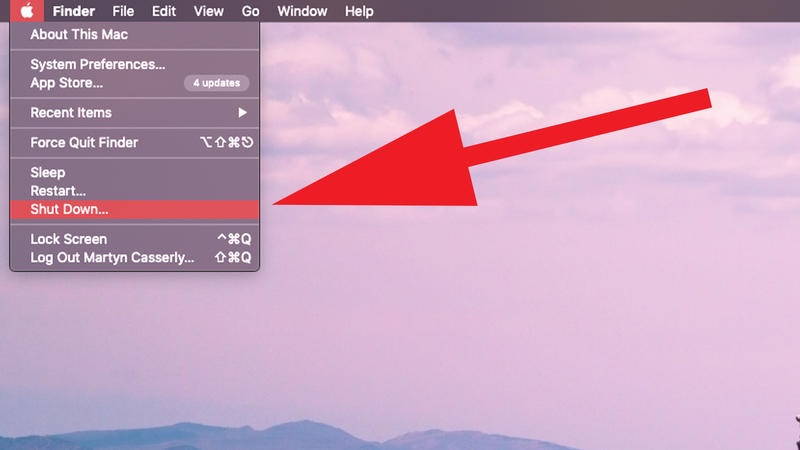
How to put a Mac to sleep
To put a Mac to sleep follow these steps:
- Click on the Apple icon in the top left on the screen.
- Select Sleep from the menu.
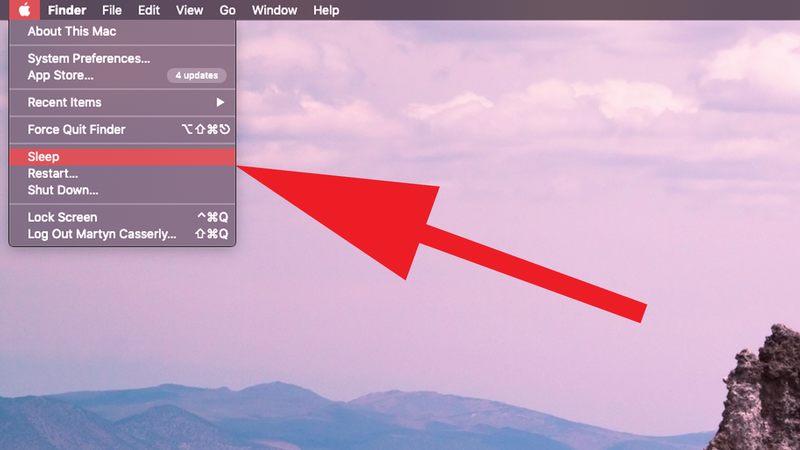
How to make a Mac go to sleep when not in use
You can also schedule your Mac to sleep after a set period of inactivity, which is useful if you often step away from your Mac in an office environment and want to keep your work safe from prying eyes. It’s also handy if at the end of the day you might forget to do it manually. Plus it will save your battery if you are working on a MacBook.
To set a Mac to automatically sleep after it’s been left for an amount of time follow these steps:
In macOS Ventura or later:
In macOS Ventura Apple made many changes to System Preferences – including renaming it System Settings. One of the big changes is in the Energy Saver/Battery settings – this no longer includes the slider that determines the amount of time after which the display will be turned off. Instead, you need to follow these steps:
- Open System Settings.
- Go to Lock Screen.
- Beside Turn display off when inactive choose an amount of time.
- In Sonoma go to Energy Saver and make sure that Prevent automatic sleeping when the display is off is unselected (to make your Mac sleep when the screen is off.)
- In Ventura go to Displays > Advanced and choose Prevent automatic sleeping when the display is off is unselected.
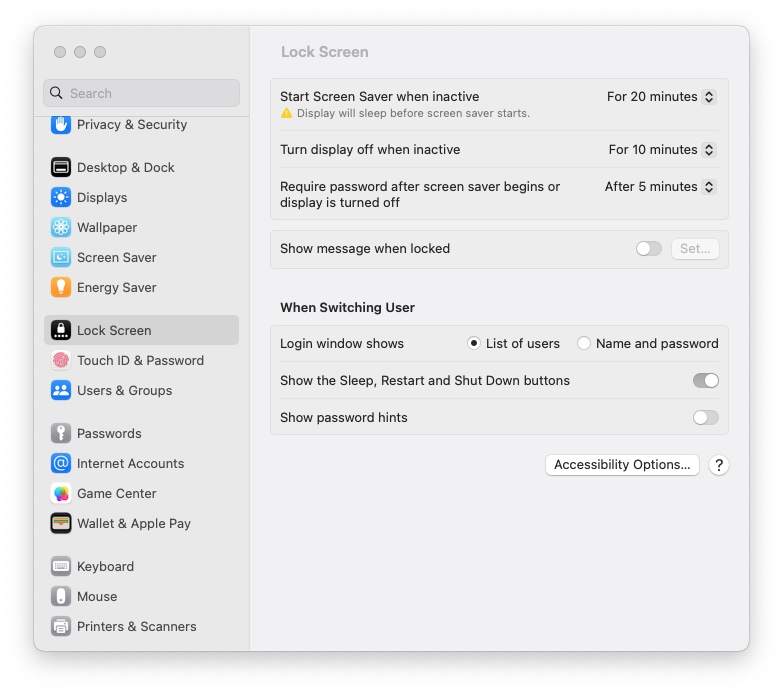
Foundry
Pre macOS Ventura:
- Open System Preferences.
- Click on Energy Saver or Battery (depending on whether you are on a Mac or MacBook). On a MacBook you’ll see two options (Battery and Power Adapter) or just Power Adapter on iMacs and Mac minis as they don’t have batteries. On a desktop Mac click on Power Adapter, on a MacBook you’ll need to follow the next steps for both Battery and Power Adapter.
- You’ll see a slider along the top which lets you set how long the Mac needs to be idle before the display is turned off. Choose a sensible amount, as 2 minutes will get very irksome if you’re thinking about things while writing a document or presentation.
- In the Power Adapter section ensure that the Prevent computer from sleeping automatically when the display is off doesn’t have its checkbox ticked.
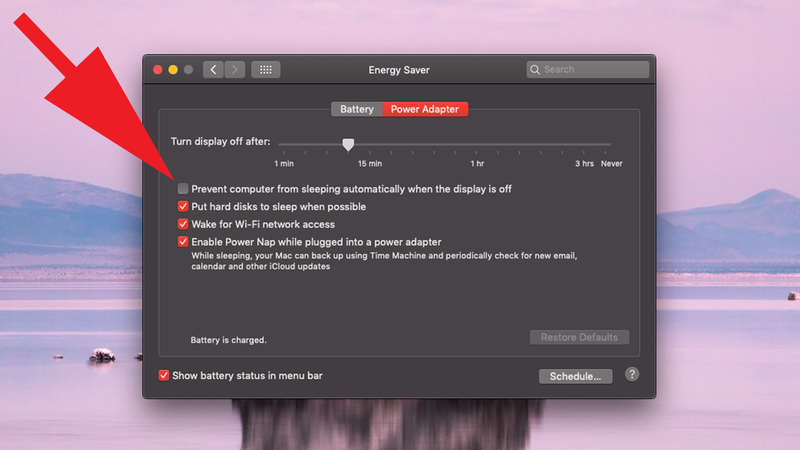
Foundry
You’ll find a few other options there to tailor your Mac’s behavior, such as putting the hard disks to sleep, and we recommend turning all of them on.
How to schedule when your Mac goes to sleep or shuts down
If you are particularly forgetful, you can set specific times when your Mac will go to sleep or shut down and wake back up again. This could be helpful if you want to mark the beginning and end of the working day, for example, or just ensure your Mac wakes up once in a while if you are unlikely to be using it for some time.
In macOS Ventura or later
As we mentioned above, in macOS Ventura Apple turned System Preferences into System Settings. Unfortunately, Schedule settings are no longer available. However, all is not lost: if you are using Ventura you can still schedule your Mac to turn on or off, you just need to use Terminal. We explain how to use Terminal to turn off your Mac in Ventura in How to schedule your Mac to turn off and on.
If you feel confident enough to use Terminal this is what you need to do:
- Open Terminal.
- enter one of the following pmset commands:
- pmset -g sched: See the current schedule.
- sudo pmset repeat wake M 8:00:00: Schedule your Mac to wake at 8:00 a.m. every Monday.
- sudo pmset repeat cancel: Cancel the current schedule.
- Press Return.
Pre macOS Ventura
If you haven’t updated beyond Monterey you can follow these steps to schedule your Mac to shut down and start up:
1. Open System Preferences > Energy Saver.
2. Click on the Schedule button in the bottom-right corner.
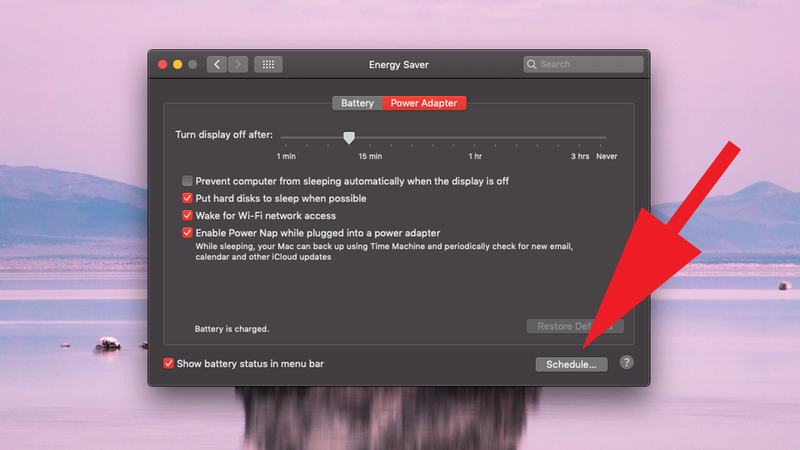
3. You can now click the Start up or wake box to choose when the Mac will be ready for action (be it weekdays, weekends, every day or specific ones).
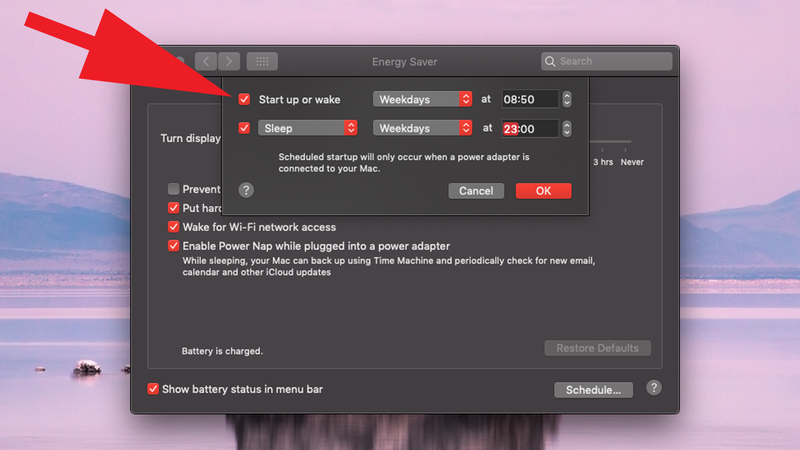
4. Beneath this you’ll see another tickbox with Sleep next to it. Select this.
5. Click on Sleep to open the other options, which are Restart and Shut Down.
6. Now, set the time when you want to revive your Mac, and when you’re happy with the schedule click OK to put this into action.
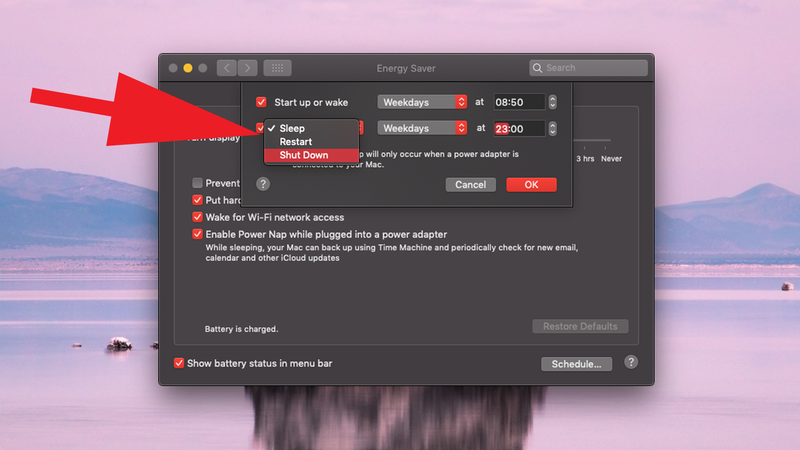
One thing you’ll need to remember is that open applications will often prevent macOS from shutting down, as the operating system doesn’t want to accidentally cause you to lose important work that might be unsaved. To ensure the automatic shut-down works you’ll need to close everything when you finish using your Mac.
How long is too long to leave a Mac switched off?
If you are going to be storing your Mac unused for an extended period of time, Apple recommends that you don’t leave its battery fully charged (100%) or fully discharged (0%).
If stored fully charged for a long time, the battery may lose some capacity, which can shorten battery life. If stored fully discharged, the battery could fall into a deep discharge state, which renders it incapable of holding a charge.
Apps that improve performance and clear RAM
If the primary reason for shutting down your Mac is to improve performance, then you might also want to consider Mac cleaning software that can automatically keep things clear of clutter and stop apps from getting greedy with your resources. We’ve had good experiences with Nektony’s Mac Cleaner Pro ($44.95/£49.95)and MacPaw’s CleanMyMac X ($34.95/£29.95), but you’ll find some other fine options in our roundup of the best Mac cleaner software and optimisation utilities.
We also have these tips for freeing up the RAM in your Mac. There are some great apps that can clear your RAM without you needing to shut down your Mac. One option is Parallels Toolbox, which includes more than 30 tools – one of which is a handy Free Memory tool. You can get a free 7-day trial, after which it’s $24.99/£20.99 a year. Read our review of Parallels Toolbox.






